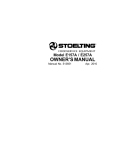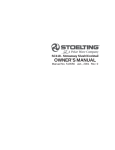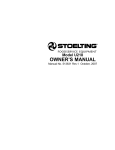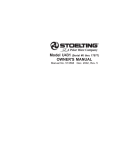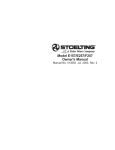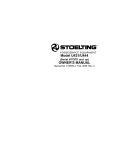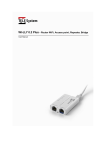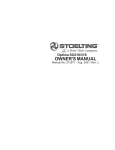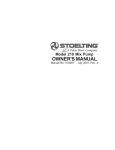Download U3-02a Owner`s Manual - Kool Technologies Inc
Transcript
U3-02A Mix Pump Owner's/Service Manual Manual No. 513606 Rev. 0, April, 2004 INTRODUCTION U3-02A MIX PUMP - OWNER'S / SERVICE MANUAL This manual provides basic information about the mix pump and its components. Instructions and suggestions are given covering its basic operation and care. The illustrations and specifications are not binding in detail. We reserve the right to make changes at any time without notice to mix pump or components without incurring any obligation to equip same on mix pump built prior to date of change. DO NOT ATTEMPT to operate the mix pump until instructions and safety precautions in the manual are read completely and thoroughly understood. The mix pump should be operated only by qualified personnel. If problems develop or questions arise in connection with the installation, operation, or servicing of the mix pump, contact your local distributor or the company at the following location: STOELTING, LLC 502 HWY. 67 KIEL, WISCONSIN 53042-1600 Ph: 920-894-2293 Fax: 920-894-7029 A Few Words About Safety Safety Information Read and understand the entire manual before operating or maintaining Stoelting equipment. This Owner's Manual provides the operator with information for the safe operation and maintenance of Stoelting equipment. As with any machine, there are hazards associated with their operation. For this reason safety is emphasized throughout the manual. To highlight specific safety information, the following safety definitions are provided to assist the reader. The purpose of safety symbols is to attract your attention to possible dangers. The safety symbols, and their explanations, deserve your careful attention and understanding. The safety warnings do not by themselves eliminate any danger. The instructions or warnings they give are not substitutes for proper accident prevention measures. If you need to replace a part, use genuine Stoelting parts with the correct part number or an equivalent part. We strongly recommend that you do not use replacement parts of inferior quality. Safety Alert Symbol: This symbol Indicates danger, warning or caution. Attention is required in order to avoid serious personal injury. The message that follows the symbol contains important information about safety. Signal Word: Signal words are distinctive words used throughout this manual that alert the reader to the existence and relative degree of a hazard. WARNING The signal word “WARNING” indicates a potentially hazardous situation, which, if not avoided, may result in death or serious injury and equipment/property damage. CAUTION The signal word “CAUTION” indicates a potentially hazardous situation, which, if not avoided, may result in minor or moderate injury and equipment/property damage. CAUTION The signal word “CAUTION” not preceded by the safety alert symbol indicates a potentially hazardous situation, which, if not avoided, may result in equipment/ property damage. NOTICE The signal word “NOTICE” indicates information or procedures that relate directly or indirectly to the safety or personnel or equipment/property. TABLE OF CONTENTS SECTION 1 — INTRODUCTION ............................................................................................................................ 1 1.1 1.2 Description ..................................................................................................................................................... 1 Specifications ................................................................................................................................................. 1 SECTION 2 — INSTALLATION INSTRUCTIONS ................................................................................................... 3 2.1 2.2 2.3 2.4 Shipment and Transit ..................................................................................................................................... 3 National Sanitation Foundation Compliance Requirements ............................................................................ 3 Installation ...................................................................................................................................................... 3 Mix Pump Check Out ..................................................................................................................................... 5 SECTION 3 — OPERATION INSTRUCTIONS ....................................................................................................... 7 3.1 3.2 3.3 3.4 3.5 3.6 3.7 Safety Precautions ......................................................................................................................................... 7 Pump Motor Switch ........................................................................................................................................ 7 Operation Of U3 Mix Pump ............................................................................................................................ 7 Cleaning ......................................................................................................................................................... 8 Disassembly and Inspection of Removable Parts .......................................................................................... 8 Sanitizing and Startup .................................................................................................................................... 9 Cleaning Mix Lines ....................................................................................................................................... 10 SECTION 4 — MAINTENANCE INSTRUCTIONS ............................................................................................... 11 4.1 4.2 Overrun Adjustment ....................................................................................................................................... 11 Preventative Maintenance .............................................................................................................................. 11 SECTION 5 — TROUBLESHOOTING ................................................................................................................ 13 SECTION 6 — REPLACEMENT PARTS INFORMATION .................................................................................... 15 6.1 6.2 How to Order Replacement Parts ................................................................................................................. 15 Parts List and Reference Drawings ............................................................................................................. 15 WARRANTY ........................................................................................................................................................... 23 LIST OF ILLUSTRATIONS Figure Description Page 1 U3-02A Pump .......................................................................................................... 1 2 Mix Transfer Line .................................................................................................... 3 A Mix Pump Hose ...................................................................................................... 4 B Pickup Hose ........................................................................................................... 4 C Pickup Hose ........................................................................................................... 4 3 D Mix Pump Installation .............................................................................................. 5 3-way Tee Connection ............................................................................................. 5 4 Pump Motor Switch ................................................................................................. 7 5 Mix Pump Operation ............................................................................................... 8 6 Removing Parts ...................................................................................................... 8 7 Overrun Adjustment ................................................................................................ 11 8 Reposition Mix Pump Hose ..................................................................................... 12 9 Pump Roller Assembly............................................................................................ 12 10 Pump and Decal Assembly ..................................................................................... 15 Exploded Parts Illustrations ..................................................................................... 17-21 Wiring Diagram ........................................................................................................ 22 SECTION 1 INTRODUCTION 1.1 DESCRIPTION The Model U3-02A Remote Mix Pump is specially designed for use with Stoelting remote pressurized freezers. Used with large capacity mix containers located in your bulk storage cooler, the U3-02A Pump keeps mix handling to a minimum. 1.2 SPECIFICATIONS WEIGHT 24 lbs. (10.89 kg) DIMENSIONS Width: 9-3/4" (24.8 cm) Height: 8-1/2" (21.6 cm) Depth: 10-1/8" (25.7 cm) Stoelting’s Model U3-02A Remote Mix Pump performs three important functions with precision and reliability. First, it transfers a continuous supply of mix from your remote storage container to the freezing cylinder of your freezer, quickly and conveniently. Second, the U3-02A Pump precisely injects a preset amount of air into the mix, maintaining overrun to assure maximum profitability. Third, it pressurizes the freezing cylinder, forcing frozen product through the spigot at the rapid dispense rates needed by high volume locations. ELECTRICAL 1 phase, 115 volts. Approximately 1.6 total running amps. Cord and plug attached. WARRANTY One year parts. UL, C-UL Approved, NSF Approved Figure 1 U3-02A Pump 1 2 SECTION 2 INSTALLATION INSTRUCTIONS 2.1 SHIPMENT AND TRANSIT The mix pump has been completely assembled, operated and inspected at the factory. Upon arrival at the final destination, the mix pump must be checked for any damage that may have occurred during transit. 2.3 INSTALLATION A. Follow the steps below to install the mix pump in an upright position on the wall using optional pump mounting kit. Allow clearance for a mix container under pump. See Figure 2. The mix pump should arrive in satisfactory condition. THE CARRIER IS RESPONSIBLE FOR ALL DAMAGE IN TRANSIT, WHETHER VISIBLE OR CONCEALED. Do not pay the freight bill until you have checked the equipment. Have the carrier note any visible damage on the freight bill. If concealed damage and/or shortage is found later, advise the carrier inspector within 10 days and request inspection. The customer must place claim for damages and/or shortages in shipment with the carrier. Stoelting, LLC cannot make any claims against the carrier. 1.Mount by locating four (4) hole centers on cooler wall using mounting bracket as template. WARNING Risk of Personal Injury/property Damage Verify electrical and refrigeration line location inside and behind the cooler's walls defore drilling. 2.2 NATIONAL SANITATION FOUNDATION COMPLIANCE REQUIREMENTS 2. Drill four (4) 1/2 inch diameter holes into cooler wall 3/4 inch deep. See Figure 3. In order to comply with "NSF International" (NSF) code #6: 3.Insert well-nut to flange and apply silicone sealant around outside diameter of flange and cooler wall. 4.Repeat steps 2 & 3 for other located hole centers. A. This unit (remote pump) must be installed with a “NSF” listed refrigerated mix transfer line. The mix transfer line must be pitched to cooler, with no sags or low points, to allow complete drainage (Fig. 2). 5.Mount bracket to cooler wall with supplied wing screws. Hand tighten until secure. B. The product at the mix pump and in transfer lines must be maintained below 41°F (5°C.) 6.Thread plastic standoffs (small parts bag) onto all three pump mounting studs located under the pump until bottomed. 7.Mount pump to bracket with wing nuts. Pump will be held above the bracket by the standoffs. 20 FT. MAXIMUM COOLER WALL 10 FT. LIFT MAXIMUM FREEZER PUMP CHECK VALVE REFRIGERATION UNIT FOR MIX LINE MIX CONTAINER Figure 2 Mix Transfer Line 3 B. Mix Pump Hose Installation. Follow the steps below to install the mix pump hose. 1. Turn pump on. 2. Feed one end of mix pump hose into the entering or pick-up hose side (left) of black cover. 3. Gently push the hose into the black cover until it begins to feed. See Figure A. Figure B 7. Turn pump on. 8. Gently pull on the discharge hose to help remaining 6" of mix pump hose to feed thru pump until hose adapter prevents further feeding. 9. Turn pump off. See Figure C. Figure A 4. Allow the hose to feed itself thru the pump until 6" remains on the entering side. 5. Turn pump off. 6. Connect mix pump hose to pickup hose adapter using small hose clamp. See Figure B. CAUTION Risk of Product Damage Avoid twisting mix pump hose while feeding into cover. Twisting the hose may cause the hose to rupture. Figure C 4 C. Connect 1/2 inch (1.27 cm) I.D. plastic food grade tubing to the mix check valve and then to the mix container. Observe check valve flow arrow. Secure with hose clamps. D. Connect 1/2 inch (1.27 cm) ID plastic food grade tubing between the large port of air/mix tee and refrigerated mix transfer line. Secure with large hose clamp or equivalent. CAUTION Risk of Product Damage Air/mix Tee must remain below the black Cover/clamp. If the Tee is above the pump, mix will drain to the air compressor resulting in pump damage. OPTIONAL MOUNTING KIT E. Plug mix pump into a 115 volt grounded receptacle. Figure 3 Mix Pump Installation 10. Connect free end of mix pump hose to 3-way Tee as shown in Figure D. When all connections are complete the 3-way Tee must be lower than the black pump housing. WARNING Hazardous Voltage Remote mix pump must be plugged into a propely grounded electrical receptacle. Do not alter the plug or add a ground adapter plug. . Altering the plug to fit into an outlet of different configuration may cause fire, risk of electrical shock, product damage and will void the warranty. 2.4 MIX PUMP CHECK OUT Before using, the U3-02A Mix Pump should be thoroughly cleaned. This is necessary to remove any foreign materials that may be present. A. The overrun adjustment is preset at the factory. If an adjustment becomes necessary, refer to Section 4.1. B. Check for air leaks by placing the suction line into two gallons of cold water. Place the freezer switch in the OFF position. Close the spigot and freezer air bleed valve. Place mix pump switch in the ON position and allow the system pressure to build up and pump to shut OFF automatically. Leave the pump on for ten minutes. 3-WAY TEE CONNECTION Figure D During this time, do not open spigot or freezer air bleed valve. If pump does not automatically start again during this period, the system is free of leaks. If the pump does start, there is a leak in the system. Locate leak by applying a liquid detergent or bubble solution with a small brush to all tubing connections and O-ring seals. Correct as required. 5 6 SECTION 3 OPERATION INSTRUCTIONS 3.2 PUMP MOTOR SWITCH The PUMP MOTOR switch (Fig. 4) is located on the mix pump assembly. When the pump motor switch is placed in the ON position, the mix pump motor will be actuated to pump mix into the freezer cylinder. When the set pressure is reached, the mix pump will shut off automatically. When the pump motor switch is placed in the OFF position, the mix pump will be inoperative. 3.1 SAFETY PRECAUTIONS Do not attempt to operate the U3-02A pump until the safety precautions and operating instructions in the manual are read completely and thoroughly understood. Take notice of all warning labels on the U3-02A pump. The labels have been put there to help in maintaining a safe working environment. The labels are designed to withstand washing and cleaning. All labels must remain legible for the life of the mix pump. Warning labels should be checked periodically to be sure they have not been removed, painted over, rubbed off, and can be recognized as warning labels. NOTE The mix pump motor is equipped with an internal overload that will “trip”, disabling the pump when the motor is overloaded. Consult the trouble shooting section for corrective information.The internal overload will automatically reset after cooling. If the condition continues, contact a qualified service person. If replacement labels are needed, indicate the part number, type of label, location of label, and quantity required. Mail your name and address to: STOELTING, LLC ATTENTION: Customer Service 502 Hwy 67 Kiel, Wisconsin 53042 Labels will be furnished and mailed at no charge. Figure 4 Pump Motor Switch SAFE OPERATION IS NO ACCIDENT; Observe these rules: 3.3 OPERATION OF U3 MIX PUMP This section describes the operation of the U3 mix pump. A. Know the U3-02A pump - read and understand the Owner’s Manual. CAUTION B. Wear proper clothing - avoid loose fitting garments, and remove watches, rings or jewelry which could cause a serious accident. Risk of Product Damage Mix pump hose must be repositioned every 1 -2 weeks. Failure to comply will result in reduced mix pump liquid capacity, dispense stoppage, popping, and possible mix pump hose leakage. Hose leakage may damage the pump roller assembly and void the factory warranty. C. Maintain a clean work area - avoid tripping or slipping by cleaning up the area and keeping it clean. D. Stay alert at all times - know which switch, push button or control you are about to use and what effect it is going to have. A. Refer to freezer owners manual for the operation of the freezer. E. Turn all switches to OFF prior to making any adjustments. B. Mix Operation: The peristaltic mix pump contains one continuous mix pump hose. When looking at the face of the peristaltic mix pump, the left side of this hose is the suction or pickup. The right side of the hose is the discharge. Mix is drawn up the suction side of the hose and transferred thru the discharge side to the freezer (Fig. 5). F. Do not attempt to repair or perform maintenance on the mix pump until the main electrical power has been disconnected. G. Do not operate the mix pump if unusual or excessive noise or vibration occurs. 7 C. Air Operation: The air compressor operates concurrently with the peristaltic mix pump. Air enters thru an intake check valve on the piston downstroke. The air is discharged thru an output check valve, and second check valve on the piston upstroke. The air and mix join at the tee and then travel to the freezer. ROLLER MIX PILLOW COVER/CLAMP INLET SIDE 3-WAY TEE Figure 5 Mix Pump Operation D. Overpressure Relief: Excess pressure is relieved backwards through the peristaltic mix pump and out the pickup side of the mix pump hose. This will occur only if the pressure switch fails to shut off the pump motor. 3.5 DISASSEMBLY AND INSPECTION OF REMOVABLE PARTS Inspection of removable parts should be made whenever maintenance is performed or pump requires disassembly. 3.4 CLEANING The mix pump must be cleaned when changing mix or whenever the freezer is shut off for an extended period, such as overnight or on nonbusiness days. For sanitary reasons, mix must not be allowed to remain in the freezer lines or mix pump when the freezer is not in operation. WARNING Hazardous Moving Parts Revolving pump head can grab, mangle, and cause serious crushing injury. The Power switch must be placed in the OFF position for cleaning and power must be disconnected when disassembling or servicing. NOTE To clean the freezer, refer to the freezer owner’s manual for complete cleaning procedures. 1. Place the CLEAN-OFF-ON switch in the clean position and agitate 5-10 minutes maximum. 2. Remove suction tube from mix container. Draw off the mix remaining in freezer barrel. 3. Pump 2 gallons (7.5 liters) of cold potable water thru freezer until water at spigot is free of mix. 4. Pump 2 gallons (7.5 liters) of 120ºF detergent solution water thru freezer. The use of soft water is recommended, along with dishwashing detergents such as “Joy,” “Dawn,” or equivalent. 5. Place mix pump switch in OFF position. Open spigot to relieve remaining pressure. Figure 6 Removing Parts 6. Place the CLEAN-OFF-ON switch in the OFF position. 8 To sanitize, refer to local sanitary regulations for applicable codes and recommended disinfecting products and procedures. The frequency of cleaning must comply with local health regulations. Use a solution containing 100 PPM of free available chlorine. Use “Stera-Sheen Green Label Sanitizer and Cleaner," or others in accordance with Health Inspection Requirements. CAUTION System Under Pressure Never disconnect hoses from freezer or pump without first opening spigot to relieve pressure. NOTE If the mix lines or air line is difficult to remove, soften with a rag soaked in hot water. Hose connections may be sprayed with Haynes Sanitary Lubricant for ease of removal. Do not loosen or remove the mix pump cover wingnuts. Maintain the mix pump hose in its operational condition. NOTE Stoelting, LLC has found that STERA-SHEEN GREEN LABEL SANITIZER AND CLEANER does an effective job of properly sanitizing and cleaning a pump and soft serve freezer. We therefore include a sample with each new freezer. For further information read the directions on the packet. Other products may be as effective. 1. Loosen clamp and remove air hose from pump compressor. CAUTION 2. Loosen clamp and disconnect mix pump hose. Remove the pickup hose, mix check valve and pickup hose adapter (and bag adapter if applicable) as an assembly from mix container. Risk of Product Damage Avoid prolonged contact of sanitizer with freezer. Prolonged contact may cause corrosion of stainless steel parts and void factory warranty. 3. Completely disassemble both hose assemblies and check valve. Place hoses, tee, check valve assembly, and pickup hose adapter in mild detergent water and wash thoroughly. Use soft bristle brushes to clean inside of fittings. Rinse all parts in clean 120ºF water. In general, sanitizing may be conducted as follows: 1. Prepare two gallons (7.5 liters) of sanitizing solution following manufacturer’s instruction, and place pump suction (inlet) line into solution. 4. Carefully inspect each part for wear or damage. Replace worn or damaged parts. 2. Place mix pump switch in ON position. 5. Prepare two gallons (7.5 liters) of sanitizing solution using a USDA certified grade sanitizing solution. Sanitize all removed parts, then air dry. 3. Check for leaks when freezer barrel is first pressurized with sanitizing solution. 4. Place freezer CLEAN-OFF-ON switch in CLEAN mode (no refrigeration). 6. Check Hose Service Record decal to determine if hose reposition or replacement is required at this time (Sec. 4.2). 5. After five minutes in CLEAN mode, open spigot and pump the remaining sanitizing solution thru the freezer, close spigot and switch the freezer and pump to OFF. 7. Reassemble both hose assemblies per the diagram (Fig.6). Reconnect assemblies to the pump and discharge hose per the diagram, using the clamps. 6. Place pickup tube into mix bag or container of mix and start the pump. CAUTION 7. Open spigot, allowing incoming mix to push remaining sanitizer out of hoses and freezing cylinder. Close spigot as soon as pure mix begins to come out (after about one pint). Risk of Product Damage Do not use excessive force when assembling parts. Parts fit together easily when properly installed. 8. Push in the air bleed valve located on the front door (Challenger Series) and allow the mix to come within 1/2" of the air bleed valve, then close the valve. 3.6 SANITIZING AND STARTUP For sanitizing to be effective, it must be performed after the mix pump and freezer parts have been cleaned, and just prior to filling the freezer with mix. Sanitizing the night before is not effective. 9. Place freezer in the on or freezing position. 9 3.7 CLEANING MIX LINES The mix lines must be cleaned and sanitized whenever changing mix or whenever the freezer is off for an extended period of time - such as overnight, or nonbusiness days. The mix lines are sufficiently cleaned and sanitized when cleaning and sanitizing the pump and freezer as an assembly. Once every 2 weeks, if required, perform the following steps: A. Mix 2 gallons (7.5 liters) of milkstone remove solution according to the directions on the container and pump through the mix line. B. Cut a piece of sponge slightly larger than the inside diameter of the mix line. Place the sponge inside the mix line and force through with tap water pressure. A garden hose repair end clamped to the mix line works well for this purpose. 10 SECTION 4 MAINTENANCE INSTRUCTIONS 4.1 OVERRUN ADJUSTMENT The product when served is a combination of air and mix. Overrun is a measure of the amount of air blended into the mix. Overrun can be expressed in terms of the amount of weight loss for a given volume. For example, if a pint of liquid mix weighs 18 ounces and a pint of frozen product with air added weighs 12 ounces, the over-run is said to be 50 percent (18 oz. - 12 oz. = 6 oz., (6 /12) x 100 = 50%. The overrun can be checked by placing a one pint container on an ice cream scale and zeroing out the scale. Then fill a one pint container with frozen product. The container should be filled over the top and leveled with a straightedge. The product should not contain any air pockets. When weighed on an ice cream scale, one pint of product should weigh 12 to 13 ounces. OVERRUN ADJUSTMENT Figure 7 Overrun Adjustment The mix pump has been preset at the factory to produce a product with approximately 40% overrun. Because of differences in mix formulation, temperatures and barometric pressure, this figure may vary. It will be necessary for approximately 2 gallons of mix to be pumped thru the freezer before changes in the product are noticeable due to adjustments in overrun. F. Tighten the allen screw, then place the wrench back in its clip. Replace the electrical box cover and screws, plug the mix pump into its grounded 115V receptacle and turn the mix pump power switch to the ON position. 4.2 PREVENTATIVE MAINTENANCE To assure trouble free operation and consistent overrun when using the U3 mix pump, we must follow mix hose repositioning and replacement procedures. The following is the preventative maintenance schedule: Overrun is controlled by the length of the air compressor piston stroke within the piston cylinder. Lengthening the stroke within the cylinder will increase overrun. Conversely, shortening the stroke will decrease overrun. To perform an overrun adjustment, refer to the following procedure: A. MIX PUMP HOSE REPOSITION (every one or two weeks.) A. Turn the mix pump switch to the OFF position and unplug the mix pump from its grounded 115V receptacle. NOTE Mix pump hose must be repositioned every 1 - 2 weeks. Failure to comply will result in reduced mix pump liquid capacity, dispense stoppage, popping, and possible mix pump hose leakage. B. Remove the 2 electrical box cover screws and remove the electrical box cover. C. On air compressor side of pump, locate the long/ slender piston rocking arm. The rocking arm downward travel is limited by a stationery cam. On the face of the cam there is an overrun setting indicator plate numbered 3 thru 8 and an adjustment knob (Fig. 7). 1. Run cleaning solution through pump. 2. Turn pump off and if connected to freezer, relieve any pressure by opening the spigot. 3. Grasp the pick-up hose end of the mix pump hose with one hand and turn the pump on. Pull down on the pick-up hose end until 12 to 14 inches of tubing has reversed fed through the pump, then turn the pump off. D. The overrun setting is indicated by a pointed pin. E. To adjust overrun, loosen the allenhead screw (located within the center of the adjustment knob) with the 5/32" allen wrench provided. Rotate the adjustment knob counterclockwise to a higher number for higher overrun, or clockwise to a lower number for lower overrun. Each number multiplied by 10 represents the overrun percentage (ie: #4 = 40% overrun). 4. Loosen small clamp at the pick-up hose adapter and disconnect mix pump hose. 5. Cut 7-1/2 inches off the end of the mix pump hose. The height of the pump can be used to measure. See Figure 8. 11 Pressures for Stoelting Freezers: Cut-out 24# ±3 PSIG For Duke Freezers: Cut-out 30# ±3 PSIG COVER/CLAMP MIX PILLOW CUT LINE MEASUREMENT (APPROX. 7 1/2") ROLLER PICK UP SIDE DISCHARGE SIDE 19 20 3-WAY TEE Figure 8. Reposition Mix Pump Hose 6. Reconnect mix pump hose to adapter. 3. Disconnect mix pump hose at each end. 7. Turn pump on. 4. Grasp the discharge hose end with one hand and turn the pump on. Pull down on the hose until all of the remaining hose is removed from the pump. 8. Gently pull on the discharge hose to help remaining 6" of mix pump hose to feed thru pump until hose adapter prevents further feeding. 9. Turn pump OFF and pump will be ready for normal operation. NOTE Each hose is long enough for 3 repositions before replacement is required. Record each event on Hose Service Record decal. 5. Turn pump roller assembly so bottom roller is at 6:00. Roller Roller Roller at 6:00 Orientation Cover/Clamp Cover/Clamp Inlet Inlet Side Discharge Discharge Side B. MIX PUMP HOSE REPLACEMENT NOTE Mix pump hose must be replaced when tubing cannot be further repositioned (every four to eight weeks). Failure to comply will result in hose failure and possible pump damage. 1. Run cleaning solution through pump. 2. Turn pump off and if connected to freezer relieve any pressure by opening the spigot. WARNING Hazardous Moving Parts Revolving pump head can grab, mangle, and cause serious crushing injury. The Power switch must be placed in the OFF position for cleaning and power must be disconnected when disassembling or servicing. CAUTION System Under Pressure Never disconnect hoses from freezer or pump without first opening spigot to relieve pressure. Figure 9. Pump Roller Assembly 6. Use a brush that fits in the opening and brush up and down, first with detergent water and then clear water. 7. Connect mix pump hose to pick-up hose adapter, using small clamp. 8. Insert free end of hose into the pick-up (suction side) hose side of the black cover. Gently push the hose into the black cover until it begins to self-feed. Allow the hose to feed itself through the pump until the mix pump hose comes out the discharge side. Then gently pull on the discharge hose to help remaining mix pump hose feed thru pump until hose adapter prevents further feeding, then turn pump off. NOTE Remove cover clamp from pump on a monthly basis to clean and check for wear. (Cover clamp & roller bearings) Clean parts with soap and water and reassemble. 9. Reconnect mix pump hose to Tee using small clamp. 12 Pump is now ready to sanitize. SECTION 5 TROUBLESHOOTING 1. PUMP MOTOR DOES NOT RUN Power to pump is off. Supply power to pump. Low voltage. Check for low voltage. Mix pump hose jammed inside black cover/clamp. Disconnect pump from power source. Remove four cover/clamp thumb screws. Separate cover/clamp halves and remove outer half. Remove jammed hose. Re-install cover/clamp and tighten four thumb screws securely. Allow motor thermal overload to reset. See Sec. 4.2 for hose replacement. Do not use jammed portion of hose. Pump motor overloaded. Allow internal thermal overload to reset; determine overload cause and repair. Pressure switch on pump is defective. Check mechanical operation and continuity of pressure switch. Defective motor/capacitor Check motor amperage draw and/or capacitor. Replace motor or capacitor. Defective toggle switch. Check continuity; repair or replace. 2. PUMP OPERATES BUT CYLINDER WILL NOT FILL NOTE 1: A PROPERLY WORKING PUMP WILL FILL AN 8 OZ. CUP WITH MIX IN ABOUT 9 SECONDS. NOTE 2: IMMEDIATELY AFTER A "BAG CHANGE" THE PUMP MAY BE UNABLE TO RE-ESTABLISH IT'S PRIME WITH THE SYSTEM AT OPERATING PRESSURE. IN THIS CASE, TURN THE PUMP OFF. DRAW 2-3 PINTS TO REDUCE SYSTEM PRESSURE TO ZERO. TURN PUMP ON. PURGE REMAINING AIR IN MIX BAG AND PICK-UP HOSE. IMPORTANT: Before connecting the pick-up hose to the mix bag, purge the mix bag of air to the extent possible. Out of Mix. Replenish mix supply. MIx pump hose kinked inside black cover/clamp. Follow mix pump hose jammed repair. (See #1 above.) Hoses assembled incorrectly. Refer to diagram for correct hose connections. Mix pump hose service life is exceeded. Reposition/replace mix pump hose. See Sec. 4.2. Mix pump hose not connected to freezer. Connect mix pump hose to freezer. Ice crystals in mix. Completely thaw mix prior to use. Mix bag drawn against adapter. Assure bag is clear of pick-up tube. Foreign objects in mix. Clear blockage. Use fresh mix. Check valve is backwards. Observe flow arrow for proper orientation. 3. OVERRUN TOO LOW OR NO OVERRUN Overrun setting too low. Increase overrun setting. Air leak. Tighten all hose clamps. Air compressor not pumping air. Contact local Stoelting Distributor. 4. OVERRUN TOO HIGH Mix pump hose service life is exceeded. Reposition/replace mix pump hose. Out of mix. Replenish mix supply. Overrun setting too high. Decrease overrun setting. Pick-up leg of mix pump hose is collapsing. See Section 4.2. NOTE: ALSO SEE "2" ABOVE. 13 5. REPLACEMENT MIX PUMP HOSE WON'T FEED THROUGH PUMP Feeding hose into discharge hole of mix pump cover. Feed hose into pick-up side of cover. Hose ends not cut squarely. Carefully cut hose end off squarely (no tails). Force feeding too quickly. Gently and slowly assist feeding of hose up into pick-up hose side of cover. Pump motor not running. Turn on motor switch. Also see Item 1 above. 6. AIR EXITING MIX PICK-UP HOSE Pickup tube check valve missing. Contact local Stoelting Distributor. 7. DISPENSED PRODUCT AIR "POPS" Overrun setting too high. Reposition/replace mix pump hose. Mix pump hose service life is exceeded. Reposition/replace mix pump hose. Overdrawing the freezer's capacity. Reduce dispense rate. Recent "mix-out" condition. Open spigot fully and allow excess air to "belch" out. NOTE: ALSO SEE 2 & 4 ABOVE. 8. MIX LEAKAGE FROM PUMP CAUTI ON: To prevent mix pump damage from dried mix deposits, immediately disassemble and clean pump. Mix pump hose service life is exceeded. Remove mix pump hose. Disconnect pump from power source. Remove mix pump cover/clamp. THOROUGHLY rinse three squeeze rollers using a spray bottle filled with hot water. Thoroughly clean all mix from pump. See Sec. 4.2 for hose replacement. Lubricate squeeze roller bearings, see Item #10 below. 9. PUMP HAS POOR CAPACITY Lift and run limits are exceeded. Pump is limited to 10' lift, 20' run. NOTE: Also see 2, 4, 6 & 7. 10. MIX IN AIR HOSE Air/mix tee above black cover/clamp. Air/mix tee must be below black cover/clamp. Air leak. Tighten all hose clamps. Mix hose on wrong air/mix tee fitting. Refer to diagram for correct hose connections. 14 SECTION 6 REPLACEMENT PARTS INFORMATION 6.1 HOW TO ORDER REPLACEMENT PARTS To assure the receipt of the proper replacement parts, supply your dealer, distributor or the company with the following information: C. Part number, part name, and quantity needed. Many part names and numbers are listed in this manual. NOTE Minimum Billing is $50.00 Net. A. Model number of equipment. 6.2 PARTS LIST AND REFERENCE DRAWINGS The following lists and drawings will aid the user when ordering parts or servicing the mix pump. B. Serial number of Model. (Stamped on nameplate). Figure 10 Pump and Decal Assembly 15 16 OPTIONAL MOUNTING KIT SEE SERVICE REFERENCE, PAGE 19 17 18 19 20 21 22 WARRANTY MIX TRANSFER PUMPS / COCKTAIL / SLUSH 1. Scope: Stoelting LLC warrants to the first user (the “Buyer”) that the evaporator assembly and compressor (if applicable) of Stoelting mix transfer pump, cocktail and slush equipment will be free from defects in materials and workmanship under normal use and proper maintenance appearing within five (5) years (two (2) years for “Mirage” equipment), and that all other components of such equipment manufactured by Stoelting will be free from defects in material and workmanship under normal use and proper maintenance appearing within twelve (12) months after the date that such equipment is originally installed. 2. Disclaimer of Other Warranties: THIS WARRANTY IS EXCLUSIVE; AND STOELTING HEREBY DISCLAIMS ANY IMPLIED WARRANTY OF MERCHANTABILITY OR FITNESS FOR PARTICULAR PURPOSE. 3. Remedies: Stoelting’s sole obligations, and Buyer’s sole remedies, for any breach of this warranty shall be the repair or (at Stoelting’s option) replacement of the affected component at Stoelting’s plant in Kiel, Wisconsin, or (again, at Stoelting’s option) refund of the purchase price of the affected equipment, and, during the first ninety (90) days of the warranty period, deinstallation/reinstallation of the affected component from/into the equipment. Those obligations/remedies are subject to the conditions that Buyer (a) signs and returns to Stoelting, upon installation, the Warranty Registration Card for the affected equipment, (b) gives Stoelting prompt written notice of any claimed breach of warranty within the applicable warranty period, and (c) delivers the affected equipment to Stoelting or its designated service location, in its original packaging/ crating, also within that period. Buyer shall bear the cost and risk of shipping to and from Stoelting’s plant or designated service location. 4. Extensions: The warranty period for deinstallation/reinstallation of the affected component from/into the equipment is extended to twelve (12) months on the following models: SO218, SO318, SO328. The warranty period for the drive motor to be free of defects in materials and workmanship extended to five (5) years on the following models: SO218, SO318, SO328. 5. Exclusions and Limitations: This warranty does not extend to parts, sometimes called “wear parts”, which are generally expected to deteriorate and to require replacement as equipment is used, including as examples but not intended to be limited to o-rings, hoses, seals and drive belts. All such parts are sold AS IS. Further, Stoelting shall not be responsible to provide any remedy under this warranty with respect to any component that fails by reason of negligence, abnormal use, misuse or abuse, use with parts or equipment not manufactured or supplied by Stoelting, or damage in transit. THE REMEDIES SET FORTH IN THIS WARRANTY SHALL BE THE SOLE LIABILITY STOELTING AND THE EXCLUSIVE REMEDY OF BUYER WITH RESPECT TO EQUIPMENT SUPPLIED BY STOELTING; AND IN NO EVENT SHALL STOELTING BE LIABLE FOR ANY INCIDENTAL OR CONSEQUENTIAL DAMAGES, WHETHER FOR BREACH OF WARRANTY OR OTHER CONTRACT BREACH, NEGLIGENCE OR OTHER TORT, OR ON ANY STRICT LIABILITY THEORY. 23 24






























